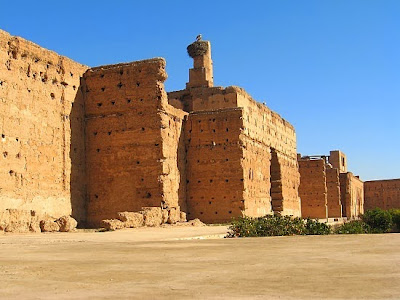Marrakech is one of Morocco’s four Imperial cities, namely – Meknes, Rabat and Fes, which originated from Amazigh – Berber words, mur n akush meaning Land of God. The city was founded in 1062 by Berber Almoravids and became the capital city of Islamic empire which stretched from central Spain to West Africa. Being the third largest city in Morocco after Rabat and Casablanca, it is located at the foothill of the snow capped Atlas Mountain and a few hours from the foot of Sahara Desert. The city of Marrakech is divided into two parts, the Medina – a historical city and the new European modern known as Gueliz or Ville Nouvelle.
While Medina is filled with inter wining narrow lanes with local shops, Gueliz on the other hand plays host to modern restaurants, big brand stores and fast food chains. It’s contrasting landscape and location has made it an attractive destination in Morocco for many holiday seekers. The vast walls surrounding the Medina were built in the 12th century from red sandstone which gave the city its name of Red City or the Ochre City and its rapid growth changed it into a religious, cultural and a trading centre. In spite of a period of decline in the later stage, it sprung back in the 16th century, during the reign of Saadian Sultans who built awesome palaces like the El Badi Palace.
There are many places of interest to explore at Marrakech and the city has several architectural and historical sites as well as some interesting museums to visit. Djemaa Ek-Fna for instance is the highlight of Marrakech night with musicians, dancers and story tellers at the square which is at the heart of Medina. Large number of stalls sells a variety of Moroccan fares and during daytime, one will find snake charmers as well as people with monkeys. The Souks or markets of Marrakech is adjacent to Place Djemaa El-Rna and one can buy almost anything like spices, tea pots, kaftans, shoes and much more from this place. Koutoubia Mosque which is besides Djemaa El-Fna is so called after the bookseller which originally was located there.
The minaret of Kouroubia mosque in Marrakech here is compared to the Eiffel Tower in Paris and the minaret can be seen from Gueliz which is connected to the Medina by Avenue Mohammed V. The mosque is beautifully lit up at night though visitors are not permitted in. Another interesting place is the Saadian Tombs which were discovered during the 20th century and have been preserved just as they were during the glorious days of the Saadian rulers.








No comments:
Post a Comment
Note: Only a member of this blog may post a comment.